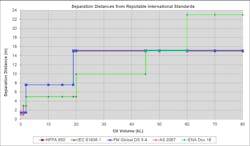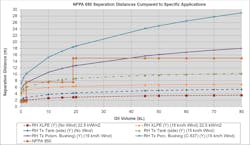‘Standard’ Transformer Fire Separation: Compliance or Negligence
Catastrophic transformer failure is the second to last consequence of an extensive list of barrier failures (Swiss-cheese model). Damage to adjacent transformers and buildings needs our attention as well to ensure all hazards have been assessed and mitigated.
As a safeguard, insurers, network owners, power utilities, and regulating bodies mandate adherence to industry standards. To achieve that, many standards have tables listing "standard" fire separation distances from oil-filled transformers based on the volume of transformer oil.
Problem Statement
Allow me the opportunity to ask the following questions:
- Does following the separation distances quoted in industry standards release the designer from their duty of care?
- Does it demonstrate due diligence on the part of the designer?
- Would lawyers agree with that?
Background
In the past, industry standards could have been prescriptive and therefore mandatory to follow. Nowadays, standards are not necessarily prescriptive, and the following disclaimers are stated:
The developer of the standard “does not independently evaluate, test, or verify the accuracy of any of the information or the soundness of any judgments’ contained in its standards.": IEEE 979 IEEE Guide for Substation Fire Protection.
“Publications have the form of recommendations for use and are accepted in that sense. All reasonable efforts are made to ensure that the technical content is accurate. No liability shall attach the developing body, its directors, employees, servants, or agents, including individual experts and members, of its technical committee for any personal injury, property damage or other damage of any nature whatsoever, whether direct or indirect, or for costs, (including legal fees) and expenses arising out of the publication, use of, or reliance upon this Publication or any other Publications.”: IEC 61936-1 Power Installations Exceeding 1 kV a.c. – Part 1: Common Rules.
- “Contains loss prevention recommendations related to the fire protection of all types of transformers.”: FM Global Property Loss Prevention Data Sheet 5-4 - Transformers.
- “The objective of this Standard is to provide common rules for the design and the erection of electrical power installations.”: AS 2067 Substations and high voltage installations exceeding 1 kV a.c.
The legislative and regulatory framework for electricity networks in some states and countries says that “nothing in a standard relieves any persons designing or working on or near electricity networks of any safety obligations imposed under jurisdictional or national work health and safety legislation.”
This means “that which is, or was at a particular time, reasonably able to be done in relation to ensuring health and safety, taking into account and weighing up all relevant matters including:
- the likelihood of the hazard or the risk concerned occurring; and
- the degree of harm that might result from the hazard or the risk; and
- what the person concerned knows, or ought reasonably to know, about:
-the hazard or the risk; and
-ways of eliminating or minimizing the risk; and
-the availability and suitability of ways to eliminate or minimize the risk.
This means “the designer must carry out, or arrange the carrying out of, any calculations, analysis, testing or examination that may be necessary for the performance of the duty imposed” above.
Fire Separation Distance Discrepancy
Industry standards define fire separation distances for oil-filled transformers in terms of transformer oil volume as shown in Figure 1 below.
Fire Hazard
A catastrophic transformer failure is only an issue when it catches fire. “The thermal radiation from a pool fire depends on a number of parameters such as composition of the hydrocarbon, size and shape of the fire, duration of the fire, its proximity of the target (i.e., the object at risk) and the thermal characteristics of the object exposed to the fire.
…Wind can significantly increase the effective pool diameter and corresponding mass burning rates. The wind tends to both tilt and increase the flame diameter in the downwind direction.
…Fire safety process performance evaluation requires a different way of thinking from the traditional practices, because a narrow emphasis on what organisations should do offers little help.”: Cigrè Brochure 537 Guide for Transformer Fire Safety Practices.
Cause for Concern
The hazard from a burning transformer to adjacent transformers or other assets is the heat radiated from the fire. The radiated heat is a function of the shape and size of the fire, which is a function of the bund size (x, y and z dimensions) that is a function of the oil volume of the transformer.
This statement brings to question the constant separation distance for various oil volumes as per Figure 1.
Further questions are whether the following were considered in the determination of the ‘standard’ separation distances:
- Validity of the ‘step’ change at certain oil volumes.
- Impact of wind.
- Impact of bund, i.e., front (length of transformer) or width (side of transformer) as transformers are typically rectangular.
- Thermal characteristics of the object exposed.
Action Plan - Performance-Based Assessment
A performance-based assessment incorporating all aspects listed above, led to the results displayed in Figure 2.
- Inadequate when it comes to porcelain bushings.
- Inadequate for polymer bushings other than 18 to 40 kL of oil.
- Overly conservative for transformer tank and XLPE cable applications.
Going forward, it is important to keep the following in mind:
- Specifying/dictating a number in a table without supporting assumptions and modeling (empirical calculations) does not meet the requirement of demonstrating due diligence, nor does it demonstrate the adequacy of the protection.
- The ‘step’ changes in the tables are confusing and inadequate compared to a performance-based assessment.
- It is recommended that Radiated Heat (RH) values be advised to which a design shall comply. These RH factors shall be supported by sound engineering, testing, manufacturers’ data sheets or other credible means.
- Adopting and implementing the performance-based method will put the designer / engineer / business in a position of prudent decision-making through:
- Understanding the limitations and conditions of the site and the designer clearly understands the impact and risk associated with a design.
- Understanding the risk and how and to what extent mitigation should be applied.
- Demonstration of due diligence.
- Do a comprehensive risk assessment to determine the overall feasibility of installing a fire wall.
Jan F Peyper is a chartered professional engineer working in the high voltage industry for the past 29 years.
About the Author
Jan F. Peyper
Jan F Peyper is a chartered professional engineer working in the high voltage industry for the past 29 years.


